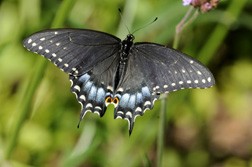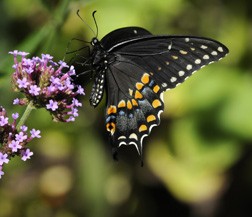Easter Black Swallowtail Butterfly
- Share
- Tweet
- Pin
- Share

Top wing surfaces of the female Eastern Black Swallowtail. Photo by Roy Lukes.
The serious drought on our peninsula has been terribly hard on many birds resulting in numerous nesting failures, primarily due to the shortage of insects. Nearly all nesting birds feed their babies insect food, one exception being the American Goldfinch which is an entirely seed-eating species. Their young are fed and will continue to eat only seeds.
Fortunately the butterflies appear to have been experiencing a good summer in that they are mainly “liquid” feeders, feasting mostly on the nectar of plants. Species include the Mourning Cloak, Northern Pearly Eye, Common Wood Nymph, Tiger and Black Swallowtails, Sulphurs, both Red and White Admirals, Painted Lady, summer form of the Spring Azure, and more recently a very nice showing of Viceroys. Monarchs were down considerably at mid-August but now are more commonly appearing at flowers. Some of the Monarchs may already be starting their southward migration to Mexico.
For many years butterflies have appealed to people for various reasons. They are gentle, slow-flying, non-biting or stinging, and colorful. Gardeners, poets, artists, nature photographers and budding naturalists find them inspirational and alluring. It is my feeling that teachers and parents should encourage children to be caring and sensitive environmentalists who will become good caretakers of their environment. Raising butterflies and observing their life cycles can do wonders toward this goal. Invariably young people who are strongly attracted to this activity will learn how mysterious, wonderful and sacred all life should be. Two of the very easiest species which children can successfully work with are the Monarch and the Eastern Black Swallowtail.

Wing undersides of a female Eastern Black Swallowtail. Photo by Roy Lukes.
Both the Tiger Swallowtail and the Eastern Black Swallowtail, which hereafter in this story will be referred to as the “EBS,” have apparently been doing very well, based upon the number being seen. Your best way to get to see these and many butterflies is to plant good nectar-producing flowers, which in turn will attract the butterflies. Flowers considered to be tops in this respect are the tall Verbena, Buddleia or Butterfly Bush, Orange Butterfly Bush (one of the milkweeds), Red or Swamp Milkweed, Coneflowers, Lantana, and the tall Tithonia (Mexican Sunflower). Undoubtedly there are others that you favor as well. The species that the EBS’s have visited by far the most often in our flower beds has been the tall Verbena.
EBS’s tend to feed at flowers fairly close to the ground and flit lazily among the plants, but threaten them with quick movements and they will quickly make their escape away from you, often in a straight line toward the nearby treetops. I have found that the lower one can get when photographing the EBS the better will be your chances of obtaining good pictures. Stay low and move very slowly. My favorite lens for butterfly and other insect photography is the 200mm “macro” mounted on an SLR camera which in turn is attached to a shoulder mount. This enables me to keep my distance from the butterfly but not scare it off quite as easily as when using a typical “point and shoot” digital camera, which I do use often.
The colors of an EBS are quite wonderful. It is fairly easy to distinguish a female of the species from a male. The male has two rows of large light-colored spots across the middle of its forewings and also some on the hindwings. Generally males are mostly black with yellowish spots. The female’s spots are smaller. She also has many more blue scales on both upper and lower surfaces of her hind wings that virtually make them appear to glow.

Eastern Black Swallowtail larva with osmeterium extended. Photo by Roy Lukes.
Both sexes have a red-orange eyespot with a centered black pupil on the corner of each hindwing, closest to the body. The far different undersides of the wings on both sexes have bright eye-catching orange spots and also more blue scales, especially on the females. It’s more challenging to see the undersides of the wings of an EBS than its upper surfaces because it usually fans its wings repeatedly as it feeds.
You are now observing the second summer brood of the EBS. The first brood generally is from May into June while the second brood runs from mid-July throughout August and into early September. These butterflies spend winter in their well-camouflaged green or brown chrysalises. A thin but strong silk thread, or girdle, supports the chrysalis securely in an angled but upright position on the rigid stalk of a plant.
Surely many of you have observed the brightly striped and spotted caterpillar of the EBS mostly eating upon one of the several members of the carrot family. Plants include Queen Anne’s Lace, garden carrots, parsley, dill and even the towering wild Cow Parsnip. What’s so fascinating about the larva, or caterpillar, is its special and unusual defense organism, its osmeterium (oz-meh-TER-ee-um). This orange to reddish forked gland directly behind its head shoots out quickly and may either spook or scare the attacker away, or offend it with its very foul odor. This protective odor is even foul-smelling to humans if they get too close to the defenseless larva.
These beautiful butterflies, with an average wingspan of about 3.5 inches, will be flying for a while feasting on the nectar of your garden flowers. We are doubly fortunate to have so many wild members of the carrot family, their host food, growing in our region, making me doubt that there will ever be a shortage of the easily-recognized and admired Eastern Black Swallowtail Butterflies.
